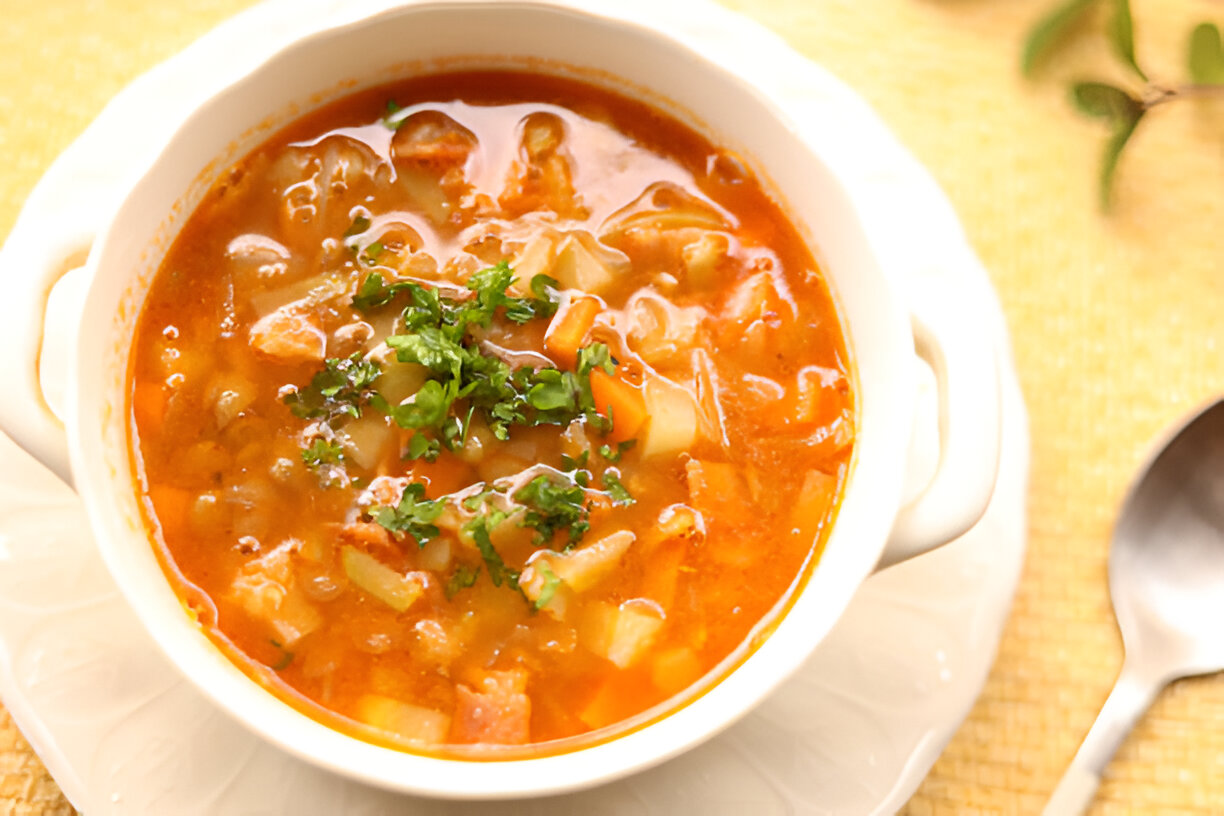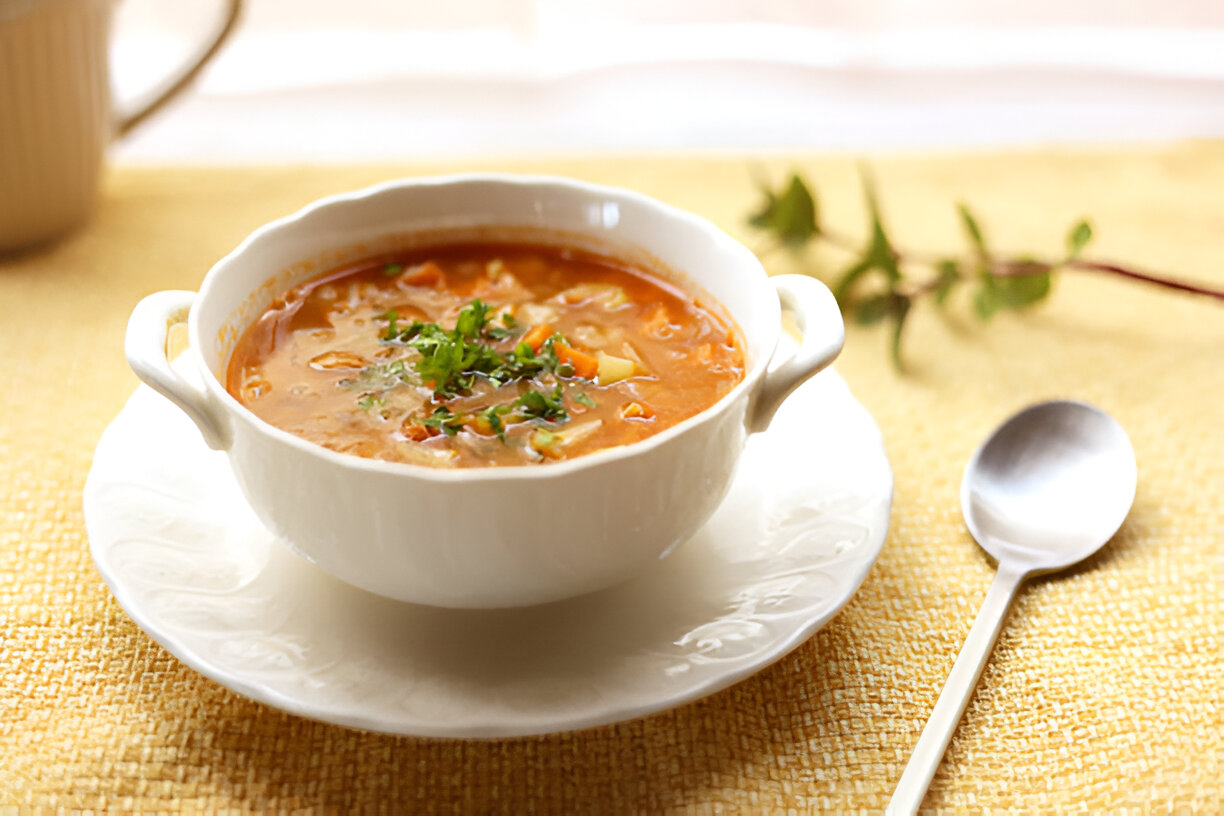Minestrone soup is a thick veggie soup that lots of people enjoy. It’s full of mixed vegetables, beans, and sometimes pasta. You can throw in almost anything you have around. Every pot ends up tasting a bit different, cause people add what they like. That’s why it’s a favorite dish all over the world.
In Italy, minestrone has a special place in the kitchen. It comes from a style called cucina povera, which means “poor kitchen.” The idea was to use simple, cheap things from the garden and turn them into something tasty. It’s not just food, it’s a way to share with family and friends, and show care by using what you’ve got.
This soup isn’t only yummy, it’s also good for you. It’s packed with vitamins, minerals, and fiber from all the veggies and beans. Beans give you protein and keep you full. Herbs and spices add flavor and even some antioxidants. Put it all together and you’ve got a dish that warms you up and helps you stay healthy.

History of Minestrone Soup
The story of minestrone goes way back to ancient Rome. Back then, people used whatever they could grow or find. They mixed in-season vegetables, beans and little bits of grain or pasta in a big pot of water. They didnt have much, but they made it work. Over time, as Italy changed, so did the soup. Up north they might add potatoes and different beans, while down south tomatoes and leafy greens are more common. Some families use meat broth, others stick to veggie broth. It all depends on the area.
Through the centuries, every region in Italy made its own version. Some are thick and heavy, others are light and full of tomato flavor. This mix-and-match style is what keeps minestrone interesting even today.
Cultural Significance
Minestrone is more than a soup; it’s a tradition in many Italian homes. Making it often brings the family together—someone chops veggies, another stirs the pot, and someone else sets the table. It shows how important it is to cook and eat with the people you care about.
On special days or simple weeknights, minestrone fits right in. It reminds people of older generations who used simple ingredients and still made something special. Every pot tells a story, mixing the season’s harvest with the cook’s own twist.

Key Ingredients in Minestrone Soup
What you put in your minestrone really matters. It’s super flexible, so you can swap stuff in and out based on your taste or what’s in season. Here are the basics:
Base Ingredients
- Broths and Stocks: You can use vegetable, chicken or beef broth, depending on what you like or what you have.
- Common Vegetables: Carrots, celery, onions and tomatoes are almost always in there. Other good picks are zucchini, spinach or whatever is fresh.
Protein Options
- Beans: Cannellini, kidney or chickpeas add protein and make the soup more filling.
- Meat Options: If you want meat, try pancetta or shredded chicken. But it’s still great as a vegetarian soup.
Grains and Pasta
- Commonly Used Types: Ditalini, orzo or brown rice help thicken the soup and give some carbs.
Herbs and Spices
- Fresh Herbs: Basil and parsley add a bright taste, while dried oregano or thyme bring deeper flavor.
- Spices that Enhance Flavor: Bay leaves and a pinch of red pepper flakes can really boost the taste.
Nutritional Benefits of Minestrone Soup
Minestrone isn’t just comfort food, it’s loaded with health perks:
Rich in Nutrients
All the veggies give vitamins A and C, potassium, and folate, which your body needs to stay strong.
High in Protein and Fiber
Beans and whole grains add protein and fiber. That helps you feel full longer and keeps your digestion on track.
Heart Health
This soup is usually low in fat and high in fiber, which is good for your heart. Veggies and beans help lower cholesterol and support a healthy heart.
Classic Minestrone Soup Recipe
Ingredients List
- Vegetables: Carrots, celery, onions, zucchini, spinach
- Legumes: Cannellini beans, kidney beans
- Grains/Pasta: Ditalini pasta or brown rice
- Broth: Vegetable or chicken broth
- Herbs/Spices: Basil, oregano, thyme, bay leaf
- Optional Add-ins: Pancetta, Parmesan cheese
Directions
- Prepare the Base: In a big pot, sauté chopped onions, carrots and celery in olive oil until they soften.
- Add Broth: Pour in your broth and bring it up to a boil.
- Incorporate Beans and Grains: Stir in the beans and your chosen pasta or grains.
- Simmer: Lower the heat and let it cook for 20–30 minutes so the flavors blend. Dont let it boil too hard or veggies might get mushy.
- Final Touches: Season with salt, pepper and fresh herbs just before serving.
- Serving Suggestions: Serve hot with extra herbs or grated cheese on top and crusty bread on the side.
Pro Tips for Perfect Minestrone
- Choosing Seasonal Vegetables: Always try to use what’s in season for the best taste.
- Adjusting Thickness: If it’s too thin, add more pasta or rice. If it’s too thick, stir in a bit more broth or water.
- Vegetarian Options: Skip the meat and use veggie broth to keep it plant-based.
Variations on Minestrone Soup
Regional Variations
Every part of Italy has its own spin on minestrone. In the north you might find potatoes and richer beans, while in the south they use more tomatoes and greens.
Vegetarian vs. Meat Versions
You can make minestrone totally vegetarian or add meats like pancetta or sausage. It just depends on what you like or need for your diet.
Creative Twists
If you want to mix it up, try adding a splash of soy sauce or miso for an Asian twist, or use your favorite local spices to make it unique.
Common Mistakes to Avoid When Making Minestrone Soup
Overcooking Vegetables
Keep an eye on the veggies so they don’t turn to mush. Different veggies cook at different speeds, so add them in stages.
Using Canned Ingredients
Canned beans and veggies are okay in a pinch, but fresh or frozen ones taste much better and aren’t soggy.
Skipping Broths/Flavor Layers
Good broth is key. Add ingredients little by little so each layer of flavor comes through, don’t dump everything in at once.
Storage and Reheating Tips
Let the soup cool completely before you put it in an airtight container. It lasts about 4 days in the fridge or 3 months in the freezer. When you reheat, do it slowly on the stove or in the microwave. If it’s too thick, just add a bit of broth or water.
Serving Suggestions
Minestrone goes great with garlic bread or a simple salad. Top it with fresh herbs or Parmesan cheese for extra flavor.
Frequently Asked Questions
What can I add to Minestrone soup for flavor?
Try a splash of balsamic vinegar, a dash of hot sauce or a squeeze of lemon juice. Fresh herbs or red pepper flakes also work well.
Can you freeze Minestrone soup?
Yes, it freezes really well. Just cool it first and use freezer-safe bags or containers.
Is Minestrone soup healthy?
Absolutely. It’s full of nutrients, high in fiber and protein, and you can make it low in fat.
What types of vegetables can I use?
Almost any you like: carrots, celery, zucchini, green beans, leafy greens. Use what’s fresh or on sale.
Can Minestrone soup be made in advance?
Definitely! Flavors usually get better after it sits for a day, making it great for meal prep.
Conclusion
Minestrone soup is easy to change up and always satisfying. Whether you stick to a classic version or add your own twist, cooking it at home is fun and rewarding. Gather your ingredients and enjoy making this warm, comforting dish!

Minestrone Soup
Equipment
- 1 large soup pot
- 1 cutting board
- 1 measuring cups
- 1 measuring spoons
- 1 ladle
- 6 serving bowls
Ingredients
- 2 tablespoons olive oil
- 1 unit onion, chopped
- 2 cloves garlic, minced
- 2 units carrots, diced
- 2 units celery stalks, diced
- 1 unit zucchini, diced
- 1 unit bell pepper (any color), diced
- 1 cup green beans, cut into 1-inch pieces
- 1 can (14.5 oz) diced tomatoes, with juice
- 4 cups vegetable broth
- 1 cup kidney beans, canned, rinsed and drained
- 1 teaspoon dried oregano
- 1 teaspoon dried basil
- to taste salt and pepper
- 1 cup small pasta (like ditalini or elbow)
- to taste fresh parsley, chopped (for garnish)
- optional grated Parmesan cheese (for serving)
Instructions
- Begin by heating the olive oil in a large soup pot over medium heat.
- Add the chopped onion and minced garlic to the pot, sautéing for about 2-3 minutes until softened and fragrant.
- Stir in the diced carrots and celery. Cook for another 5 minutes, occasionally stirring until the vegetables start to soften.
- Add the diced zucchini, bell pepper, and green beans. Cook for an additional 3-4 minutes, stirring frequently.
- Pour in the diced tomatoes along with their juice, and add the vegetable broth.
- Stir in the kidney beans, oregano, basil, salt, and pepper. Bring the mixture to a boil over high heat.
- Once boiling, reduce the heat to medium-low and let it simmer for about 15 minutes, allowing the flavors to meld.
- After 15 minutes, stir in the pasta and cook according to the package instructions (usually around 8-10 minutes) or until al dente.
- Taste the soup and adjust the seasoning if necessary.
- Serve hot, garnished with fresh chopped parsley and an optional sprinkle of grated Parmesan cheese.





Leave a Reply